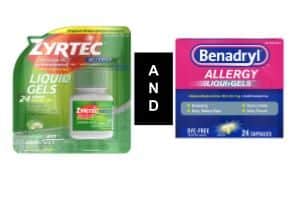
Is your dog itching all over and scratching like mad? Are his eyes watery? Is he sneezing a lot?
Looks like your pet has an allergy, but what can you do to relieve his symptoms before you see a vet and get a clear diagnostic? Can you give your dog Benadryl or Zyrtec, drugs many people already have in their medicine cabinets?
Short answer – yes, allergy drugs meant for humans are considered to be safe for pets, both dogs and cats. You need however to be very careful when you give Benadryl or Zyrtec to a dog. In this article we’ll explain what’s the proper dosage for dogs, we’ll examine possible side effects and also have a look at the most common allergies in dogs.
Can I give my dog Benadryl and Zyrtec at the same time?
There are very little studies on the safety of combining two antihistaminic drugs, but, as a general rule, experts say you should not take Benadryl and Zyrtec at the same time, as this might lead to stronger side-effects. This advice refers to human consumption, but since you’re using human drugs on your pet, the same applies to them.
If you feel one drug isn’t working for your dog, best wait till the next day to offer him a different one.
Many pet owners wonder which of the two drugs is better, but that is impossible to answer. Each dog reacts differently to them so if you have any doubts you should ask your vet what they recommend.
How much Benadryl can I give my dog?
Benadryl is the brand name for diphenhydramine, which is an antihistamine used to treat allergies in both humans and dogs. For the time being, Benadryl is not FDA-approved for use in dogs, but experts consider it’s nevertheless safe.
Veterinarians have been using human antihistamines to treat dog allergies for years and have determined how much Bendaryl is safe to give to your suffering pet. It all depends on your dog’s weight. According to the Merck Veterinary Manual, the recommended dosage for Benadryl is 2 – 4mg/ kg or 0.9 – 1.8 milligrams per pound.
If it’s the first time you’re giving Benadryl to your dog, you should give him a low dose, in case he develops side effects (more on that later). For instance, if you have a small 10 lbs dog you should give him 10 mg of Benadryl, which represents 1 mg/ pound. Likewise, a 50 lbs dog should get 50 mg of Benadryl.
Examine the type of Benadryl you have in your cabinet, see how many milligrams there are in a tablet or liquid dose and do the math. If you have 25 mg tablets, a 50 lbs dog can safely have two of them, but for a small dog you’ll have to cut it in half. Liquid Benadryl might be easier to manage as you can measure how many drops your dog can have.
You can give Benadryl to your dog 2 or 3 times a day at regular intervals.
Even if you’re not sure that your dog is indeed having an allergic reaction and not something else, you can give him some Benadryl and wait to see if there’s any improvement.
If you don’t see any improvement, you should take the dog to a vet as soon as possible as he might have other health issues.
What are the side effects of Benadryl in dogs?
First of all, you should avoid giving your dog Benadryl that might contain alcohol or decongestants. For instance, certain formulations like Benadryl Cough Syrup or Benadryl Liquid Elixir, might contain 5 – 14 % alcohol, which is toxic to dogs.
Obviously, a few drops won’t harm your dog in any way, but if he suffers from seasonal allergies and requires long-term antihistamine treatment you shouldn’t use a product that contains alcohol.
Tablets are usually safe as they do not contain alcohol at all.
Like all drugs, Benardyl can cause various side effects, such as:
- Drowsiness
- Increased heart beat
- Rapid breathing
- Inability to urinate
- Dry mouth
Some less common side effects are vomiting and diarrhea, or changes in your dog’s appetite.
Keep in mind that this advice is intended for adult dogs. If you have a puppy, a pregnant or nursing dog it’s best to talk to a vet before administering Benadryl.
How much Zyrtec can I give to my dog?
Zyrtec is another popular type of antihistamine and its active ingredient, cetirizine, is also considered safe for dogs.
According to the same Merck Veterinary Manual, the recommended dosage is 1 mg/ kg. A 10 kg (22 lbs) dog should get 10 mg. S
ome Zyrtec adult formulations contain 10 mg tablets, so one should be enough for a 10 kg dog.
Zyrtec can be given no more than once or twice a day.
The same goes for Claritin, the brand name for another antihistamine in which the main ingredient is loratadine. Claritin can be given once or twice a day and the recommended dosage is 0.2 mg/pound.
Just as with Benadryl, both Zyrtec and Claritin can cause side effects such as dry mouth and stomach problems, and drowsiness, although to a lesser extent than Benadryl.
Never leave antihistamines within the dog’s reach as he can easily chew the plastic container and overdose.. The most common signs of antihistamines overdose include dilated pupils, rapid heart rate and seizures. Take the dog to the vet right away.
What are the most common allergies in dogs?
Allergies start manifesting in dogs usually after they reach six months of age. The vast majority of dogs diagnosed with an allergy are young animals, aged one or two.
Around 10% of all dog allergies are food allergies, with the most common allergens in this category being beef, dairy products, wheat, egg, and various other types of meat. If your dog develops an allergic reaction after you’ve just changed their regular food, you’ll have to examine the ingredients on the label to see what might be causing the problem. Unfortunately, dogs can be allergic to more than one type of food so it’s going to be hard to determine what doesn’t agree with him.
At the same time, dogs can be allergic to many different things, such as pollens, mold, dust, insect bites, household chemicals and some medications.
- Seasonal allergies caused by pollen will require treatment every spring, since there’s nothing you can do about the trees growing around your house.
- Mold spores and dust are also very tricky allergens. Dogs are very inquisitive by nature and you cannot stop them from poking their nose everywhere. You can clean the house all you want, if the dog starts sniffing under the porch, he’ll inhale some mold spores and he’ll start sneezing and itching.
- Insect proteins refers to the chemicals that enter your dog’s bloodstream through flea, ticks and other insect bites. If your dog has an insect allergy, you’ll notice large bumps around the bite site. Insect bites usually cause itchiness but if the dog is also allergic, he might scratch himself raw. Always check the dog’s skin for signs of infection and use an antibiotic ointment besides the allergy drug. An allergy to flea saliva is called Flea Allergy Dermatitis. The itchiness it causes is unbearable and the dog might scratch himself until he removes clumps of hair in the affected area. Talk to your vet about the best form of flea protection for your dog.
- Some dogs can be allergic to vaccines, so it’s best to keep an eye on your pup after he gets his shots.
- As odd as it might seem, dogs can even be allergic to Benadryl, although it will be pretty hard to distinguish the signs of that from the allergy symptoms he was experiencing in the first place. If you notice any new symptom, such as seizures or the dog struggling to breathe, don’t give him another dose and seek immediate medical help. Acute allergic reactions can be lethal.
What are the most common allergy symptoms in dogs?
Dogs manifest pretty much the same allergy symptoms that people do.The most obvious one is usually itchiness.If you see your dog scratching his ears furiously, shaking his head, or licking and chewing at his paws, that’s probably due to an allergy.
Other allergy symptoms include
- Runny nose
- Watery eyes
- Hives
- Swelling and inflammation
- Coughing and sneezing
Just like people, dogs can also go into anaphylactic shock when they have an acute allergic reaction. The most serious sign of anaphylactic shock is swelling in the head area, as it might indicate swelling of the throat. You need to act quickly as the dog might stop breathing. If you have any antihistamine around, give it to the dog immediately, then head for the vet straight away.
Closing Thoughts
If your dog develops a mild allergy characterized by itchiness, runny eyes or nose, coughing and sneezing you can safely give him some of your allergy drugs. Vets routinely use Benadryl, Zyrtec or Claritin to treat allergies in dogs, but you’ll have to check out the recommended dosage, which depends on your dog’s weight. All antihistamines cause side-effects, but those are usually minor.
If you notice your dog is struggling to breathe he might be experiencing an acute allergic reaction or anaphylactic shock and this is a medical emergency.
Always keep antihistamine medications out of your dog’s sight and reach, preferably locked in a cabinet.





